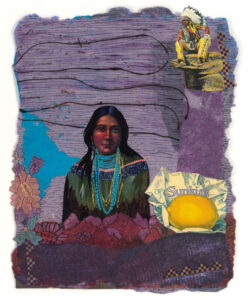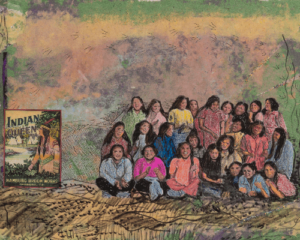In 2022, the Nevada Museum of Art will honor the Great Basin Native American artist-activist Jean LaMarr for her commitment to indigenous tradition and social justice issues. With several events planned and the publication of a 220-page hardcover book, The Art Of Jean LaMarr exhibition will be on view through July 17, 2022. This exhibition acknowledges the Wa She Shu (Washoe), Numu (Northern Paiute, Newe (Western Shoshone), Nuwu (Southern Paiute) people of the Great Basin, and the 27 tribal nations that exist as sovereign nations and continue as stewards of this land.
To get more information and insight about this retrospective exhibition, we reached out to Ann M. Wolfe, the Museum’s Andrea, and John C. Deane Family Senior Curator and Deputy Director. She spoke about the Museum’s dedication to supporting Great Basin Native American artists and how art activism can influence positive change in the world. We also asked Dana Sullivan Kilroy, a spokeswoman for the Museum, to share how visitors can get more involved with the exhibition this quarter.
Nevada Museum of Art Exhibit to Feature Great Basin Native American Artist Jean Lamarr

What are you most excited about for the Jean LaMarr exhibition?
Ann says: This exhibition features a lifetime of work by Jean LaMarr, an incredible yet underrecognized Great Basin Native American artist-activist from the Paiute/Pit River tribe in northeastern California. In my opinion, there is nothing more exciting than sharing a compelling, untold story like hers.
What role can art play in social, political, and economic change?
Ann says: Art can bring social, political, and economic awareness to issues that may not be top-of-mind for people from different cultures and backgrounds. Jean LaMarr’s artwork is an example of this by addressing the boarding schools used in the late 1800s to mid-1900s to assimilate indigenous children into a non-native society. Many Native children went missing in these schools, and families were given little to no information about their whereabouts. Now there’s evidence of mass graves like the one containing the remains of 215 indigenous children at a British Columbia boarding school.
Although this tragedy may seem far from home, many Nevadans are unaware of a similar school used in Carson City. The Stewart Indian Boarding School took native youth from their families, forced them into assimilation, and among them were LaMarr’s ancestors. Jean dedicated one of her newest sculptures to healing her family and community members’ life-long traumas caused by this.
To provide an opportunity to learn about and discuss the traumatic legacy that remains, we will host a public program called A Community Forum: Reckoning with Nevada’s Boarding School Past on March 29, 2022.
How can visitors better manage conversations about sensitive topics, such as systemic racism, cultural appropriation, and gender inequality?

Ann says: When it comes to having conversations about sensitive topics, it is essential to be an active listener and hear the stories of marginalized individuals and communities.
You can also study the art of artists like Jean LaMarr, who uses striking visual images, colors, satire, and different forms of media to tackle sensitive issues.
By having deeper conversations about the world around us, her art can open the door to positive change.

How does the museum strive to support and protect Native American culture?
Ann says: The Nevada Museum of Art has a decade-long relationship with Great Basin Native American artists and Indigenous communities across the state. We organize exhibitions, publish indigenous-written books, and purchase Native American artworks to show our ongoing support.
How can visitors get more involved with the Jean LaMarr exhibition?
Dana says: Visiting our website is a great place to start. From community forum discussions to family learning experiences, there is something for everyone to get more involved with the Jean LaMarr exhibition. For more information, please see below:
 Suzan Shown Harjo on Indigenous Rights, Arts, and Activism
Suzan Shown Harjo on Indigenous Rights, Arts, and Activism
- 6 p.m., Wednesday, March 9, 2022
- $10 or free for members and tribal communities
Suzan Shown Harjo is a committed Native American activist who addresses sacred places protection and repatriation, religious freedom, treaty, inherent sovereign rights, mascot eradication, and language revitalization. Visitors are welcome to attend this event in person at the Museum’s theater or participate on Zoom as Harjo speaks virtually from Washington, D.C., to discuss past and ongoing issues surrounding artists’ rights, women’s rights, and Native rights. Dr. Debra Harry, Associate Professor in the Department of Gender, Race, and Identity, University of Nevada, Reno, will also moderate a conversation and Q&A following the presentation.
 Community Forum: Reckoning with Nevada’s Boarding School Past
Community Forum: Reckoning with Nevada’s Boarding School Past
- 5 p.m., Thursday, March 31, 2022
- $10 or free for members and tribal communities
At the beginning of 1890, thousands of Great Basin Native American children were sent to Stewart Indian Boarding School in Carson City, Nevada, as part of the U.S. government’s policy of forced assimilation. With options for in-person and Zoom attendance, community members can discuss and learn more about the history of boarding schools for the indigenous. In collaboration with the Stewart Indian School Cultural Center & Museum, this program will feature Stacey Montooth, Executive Director of the Nevada Indian Commission, and Dr. Debra Harry, Associate Professor in the Department of Gender, Race, and Identity, University of Nevada, Reno. Participants will also have the exclusive opportunity to watch the debut of LaMarr’s performance, “They Danced, They Sang, Until the Matron Came.”
Virtual Art Bite: Susan Lobo on Art as Cultural Communication and the Intersections of Contemporary Native Life
- Noon, Friday, April 8, 2022
- $10 or free for members and tribal communities
As a cultural anthropologist, Susan Lobo specializes in research and community-based advocacy work in urban and rural Native communities in the United States and Latin America. Lobo will virtually discuss the rich and layered ways Jean LaMarr’s art regards contemporary Native life and social issues via Zoom.
 Estelle J. Kelsey Foundation Hands ON!
Estelle J. Kelsey Foundation Hands ON!
- 10a.m– 4p.m., Saturday, May 14, 2022
- Free
Bring the whole family to meet Jean LaMarr and listen to Great Basin Native American speakers about indigenous tradition and culture. With performances and presentations, you can learn about Indigenous foodways and make art inspired by LaMarr’s work. Native American vendors will also offer traditional and contemporary jewelry and other unique wares for purchase.
What can we expect to see from the museum next quarter?
Ann says: From July 2 to Oct. 2, we will open a photography exhibition—Janna Ireland on the Architectural Legacy of Paul Revere Williams—to feature the contemporary photography of Janna Ireland, who explores the contributions of Paul Revere Williams. As the first licensed African American architect west of the Mississippi, Paul Revere Williams designed many of Nevada’s residential, commercial, and religious buildings. Some of his most notable designs include the La Concha Motel (now part of the Neon Museum)in Las Vegas and the First Church of Christ, Scientist (now known as the Lear Theater) in Reno.



